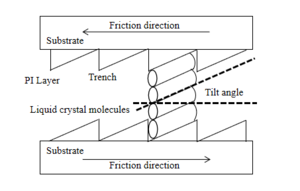Anti-glare LCD
Team members
Han Shixin(A0236394X)
Ming Xiaohan(A0236400W)
Zhang Yuanyuan(A0236393Y)
Idea
Glare is an undesirable lighting phenomenon. To suppress glare, optical films can be used. Based on the electro-optical characteristics of liquid crystals, the project aims to investigate the relationship between voltage and optical characteristics of liquid crystals. At the same time, the orientation and thickness of the liquid crystal are optimized simultaneously to obtain the design parameters of modulable liquid crystal anti-glare film, so that the liquid crystal has high diffraction efficiency at the reflecting end and low diffraction efficiency at the transmitting end.
Liquid crystal orientation technology
Liquid crystal orientation technology is the key to the preparation of liquid crystal instruments. The technology has been widely used for over a century, from 1911 to the present. The frictional orientation technique uses a material such as cotton lint or nylon, which is set in the direction of the frictional orientation and then rubbed against the orientation layer to give it a certain shape. Due to the anchoring effect of the orientation film, the molecules around the orientation layer will cause the liquid crystal layer molecules to show a certain regular arrangement, thus achieving the purpose of orientation. There are two theories of this technology: the "groove" theory and the "orientation of molecular chains on the surface of the oriented layer" theory. Groove theory refers to the higher density of grooves created by friction. From the point of view of low energy and high system stability, the liquid crystal molecules are aligned along the grooves and the intermolecular interactions result in a stable arrangement of the oriented layers.

The theory of "surface molecular chain orientation" refers to the action between the liquid crystal molecules and the orientation layer. When the orientation layer is rubbed, special molecular chains emerge, which are extended when the molecules come into contact with it, and then extend to form a specific orientation. At present, neither of these two theories provides a perfect explanation of the mechanism of frictional orientation, and this method of contact orientation has a long history, but still requires further research. Later on, some non-contact orientation techniques emerged: ion beam orientation, oblique vapour deposition, light orientation techniques, etc.. One of these technologies, photo-orientation, refers to the physical or chemical reaction that occurs when light is directed into a material, due to its photosensitive properties, thus causing the liquid crystal molecules to achieve a specific pointing. Light-controlled orientation is widely used because it avoids static electricity, dust and other contamination and can be used to make multi-domain devices.